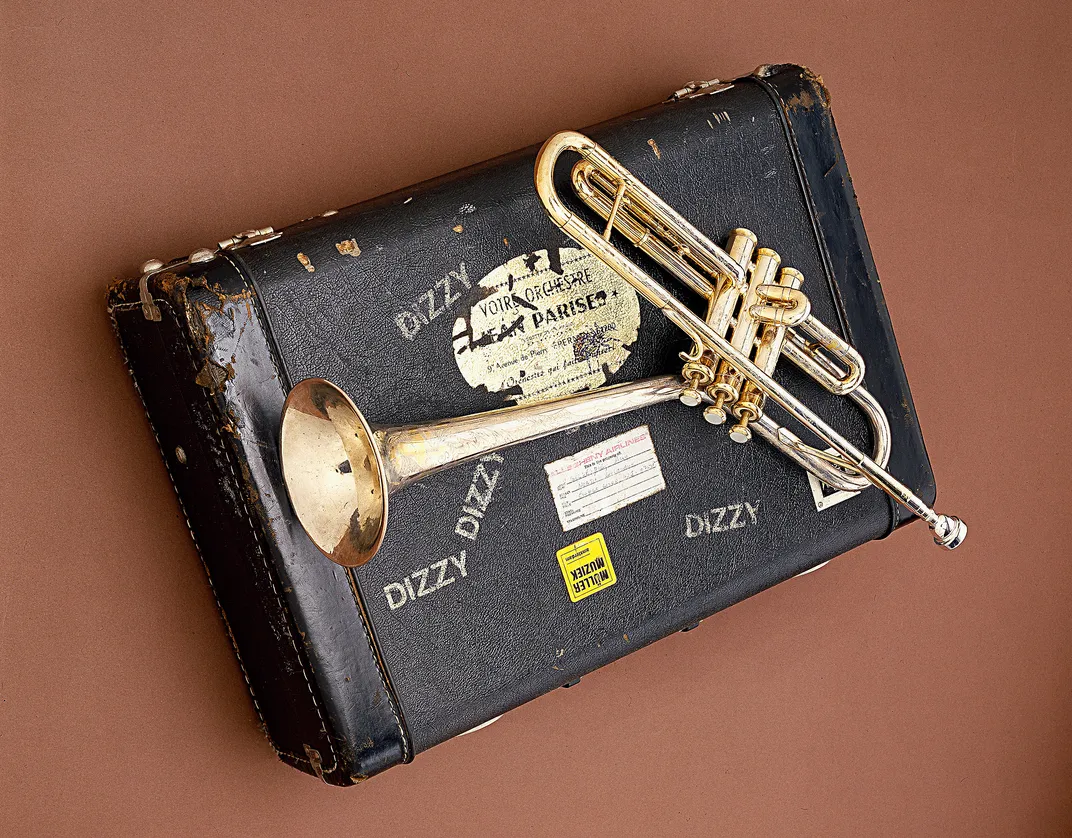Dizzy Gillespie and His Bent Trumpet
Here’s how the Smithsonian acquired the instrument of one of the world’s most influential and unconventional American jazz musicians
/https://tf-cmsv2-smithsonianmag-media.s3.amazonaws.com/filer/20/59/20593506-ce49-4ba7-958b-db1ba490f2d3/dizzy_gillespie_giants_of_jazz_1973_dia0006.jpg)
Dizzy Gillespie was one of the most influential and well-known jazz musicians of all-time. John Birks Gillespie, who passed away 25 years ago this month, he pioneered a number of jazz subgenres and became internationally famous for his legendary ability on the trumpet, his trademark “balloon cheeks,” and his playful stage presence.
But the most lasting symbol of his remarkable career may well be his signature “bent” trumpet—and the story of how the American History Museum got its hands on one of these unusual instruments is just as unconventional as Gillespie himself.
“In 1985, I was a new, fresh curator and I wanted to start collecting in the area of jazz,” says John Edward Hasse, a music curator at the museum. “I wrote Gillespie a letter, at his home address in New Jersey, inviting him to become part of the Smithsonian by donating a trumpet that he no longer played. Weeks and months went by, and no response.”
A colleague suggested to Hasse that he try writing Gillespie’s wife, Lorraine, instead. “Four days after sending the letter, this great big box arrives at the museum by UPS!” Hasse says. “In it is his trumpet and a specially built trumpet case to accommodate this unusual shape, with travel stickers from France and various parts of the world. I could hardly believe it.”
Typically, Hasse says, the donation process involves a number of planning steps, including arranging special shipping and extremely careful packing. “This just came in like ‘boom!’”
Hasse chose Gillespie as one of the musicians to build the Smithsonian’s jazz collection because of his remarkable influence on music. His career spanned seven decades and was instrumental in popularizing jazz for American mainstream audiences, as well as creating and expanding the genre to incorporate elements of other types of music.

As a young man, while playing in Cab Calloway’s Big Band at the Cotton Club in Harlem, Gillespie met a Cuban-American trumpeter and became interested in creating fusions of Afro-Cuban music with Jazz. “He then wrote several Latin-tinged compositions, such as ‘A Night in Tunisia,’ and ‘Manteca,’” Hasse says. “He was responsible, perhaps more than any other jazz musician, for making Latin rhythms an important part of American jazz music.”
Gillespie also pioneered a popular subgenre of jazz: bebop. During a musician’s recording strike in the early 1940s, he and Charlie Parker and a number of other musicians in Harlem were exploring this new approach. “When the recording ban was finally lifted in 1944, and the new style emerged on records, it jarred a lot of listeners, because it just seemed to emerge from nowhere,” Hasse says. “In 1945, he started making these recordings that really set musicians on their ears, pieces such as ‘Groovin’ High,’ ‘Hot House,’ ‘Salt Peanuts,’ and the tune that gave the music its name ‘Bebop.’”
By this time, Gillespie had already become one of the most beloved jazz artists in the county, easily identified by his pouched cheeks, which were a result of the muscles he’d built up over years of playing. “He was an amazing virtuoso on his instrument, playing faster and higher than just about anybody,” Hasse says. “He was also an irrepressible entertainer, with a winning stage personality and ability to connect with the audience.”
But it wasn’t until 1953 that, by happenstance, he acquired his final visual trademark. “Somebody fell accidentally on Gillespie’s trumpet as it was standing up on a trumpet stand, and as a result, the bell was bent,” says Hasse. “Gillespie picked it up, played it, and discovered he liked the sound, and that it projected better over the heads of the audience of people in the back of the nightclub.”
“Ever since that time,” Hasse says, “When he got a new trumpet, he had it specially made for him, with the bell bent at 45 degrees.”
/https://tf-cmsv2-smithsonianmag-media.s3.amazonaws.com/accounts/headshot/joseph-stromberg-240.jpg)
/https://tf-cmsv2-smithsonianmag-media.s3.amazonaws.com/accounts/headshot/joseph-stromberg-240.jpg)